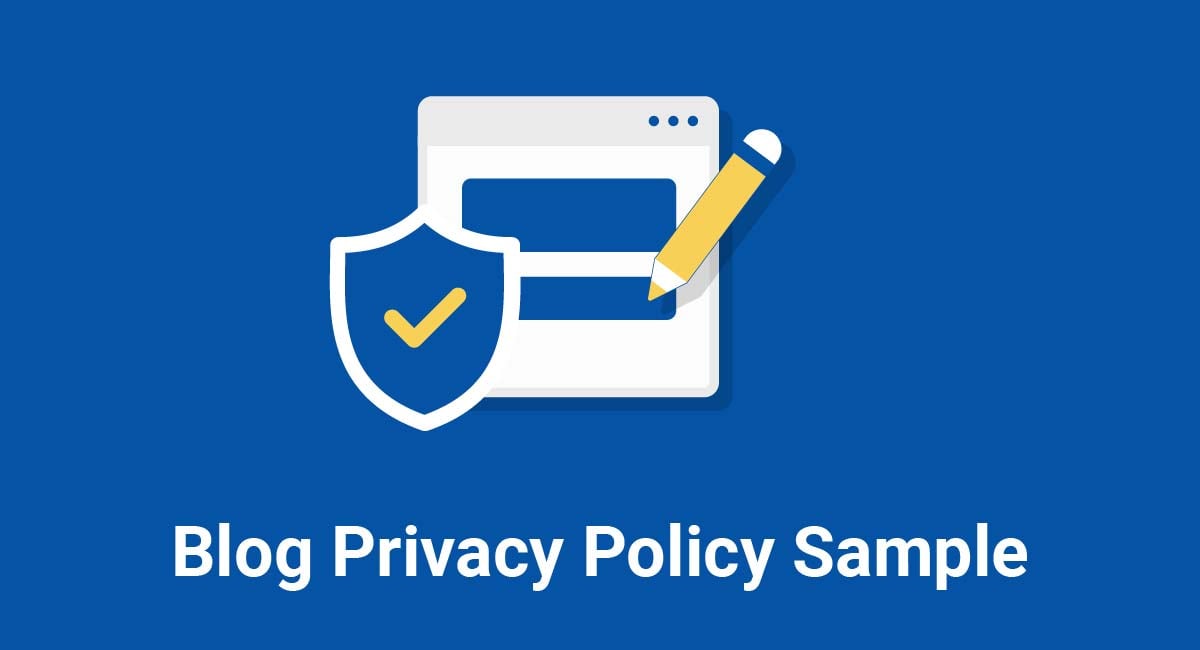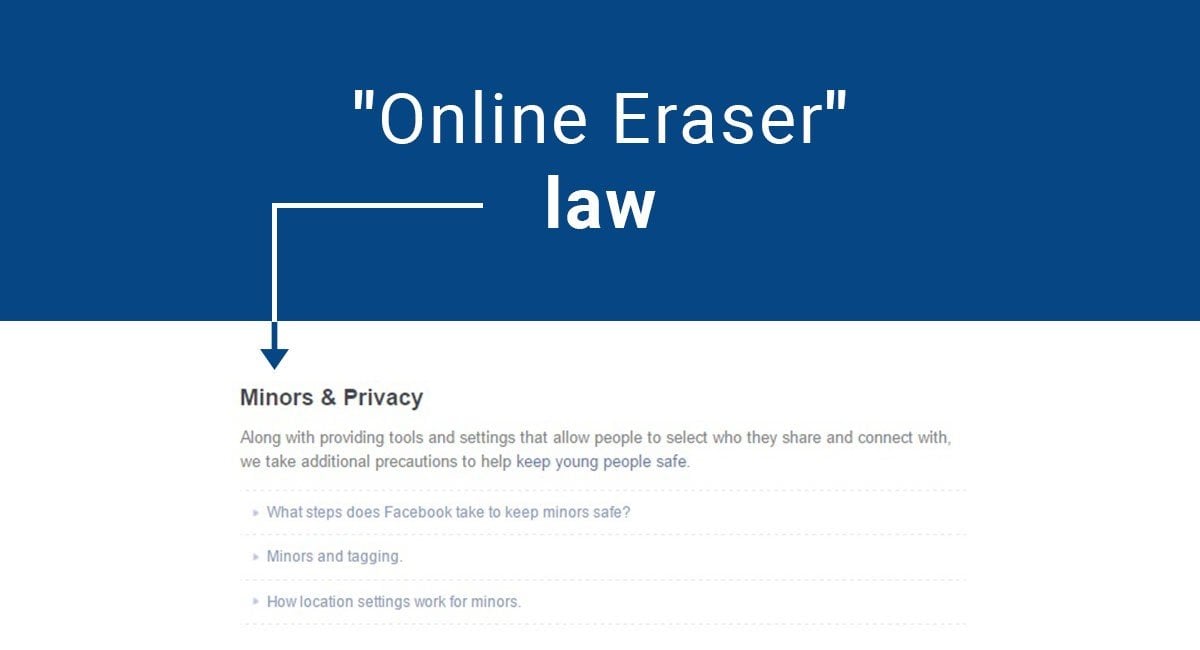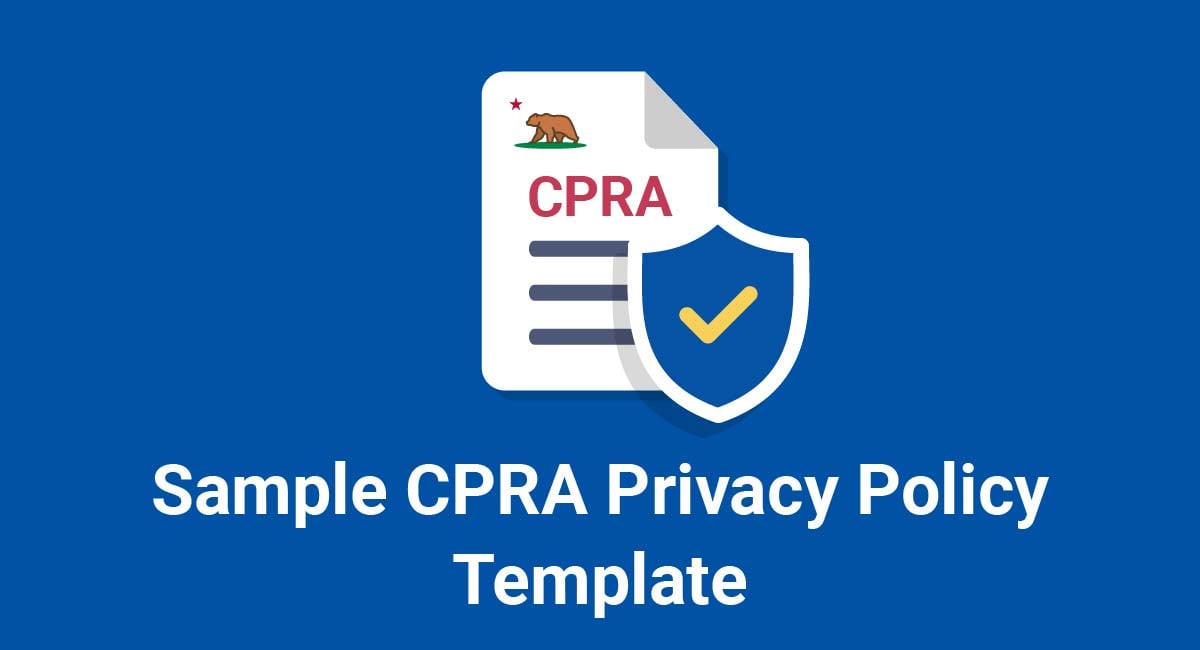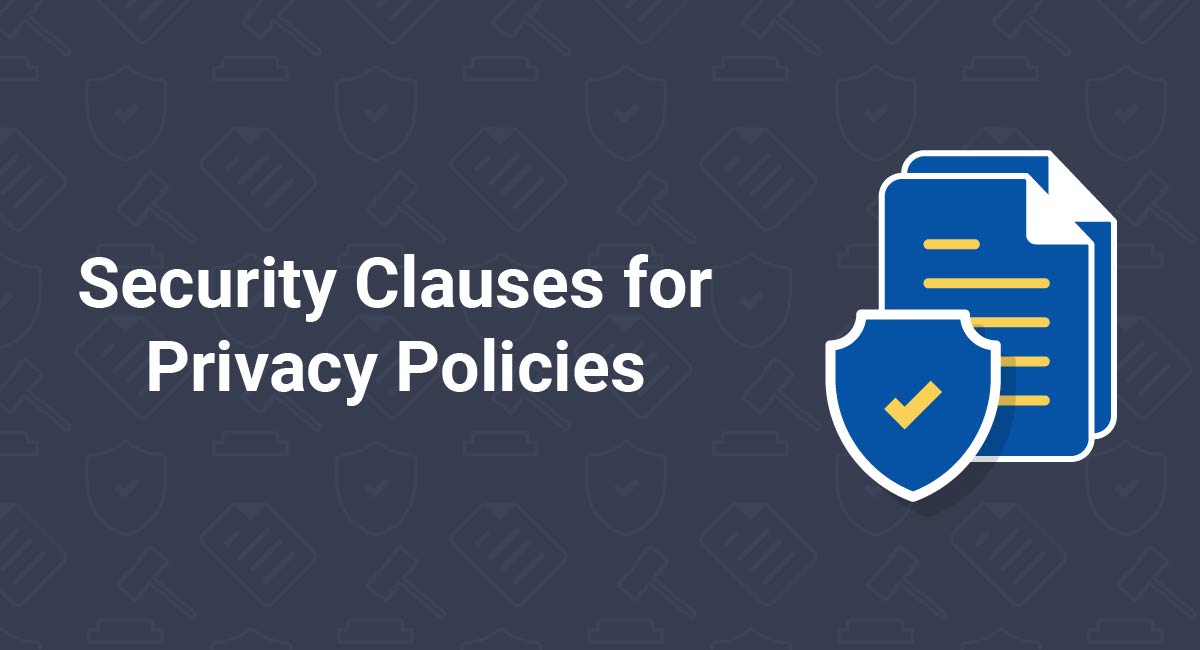It's crucial to make sure that you have a straightforward Privacy Policy posted on your blog. Not only is it legally required, but your blog's visitors will appreciate understanding what data you are collecting from them, how it's used, and with whom you may share it.
Not sure where to start? This article will take you through the fundamentals of a Privacy Policy and the kind of clauses you should include for a blog's Privacy Policy. We've also put together a Sample Blog Privacy Policy Template that you can use to help write your own.
Our Privacy Policy Generator makes it easy to create a Privacy Policy for your business. Just follow these steps:
-
At Step 1, select the Website option or App option or both.

-
Answer some questions about your website or app.

-
Answer some questions about your business.

-
Enter the email address where you'd like the Privacy Policy delivered and click "Generate."

You'll be able to instantly access and download your new Privacy Policy.
- 1. Privacy Policies are Required by Law, Even for Blogs
- 2. Third Parties and Privacy Policies
- 3. What Kinds of Personal Information Do Blogs Collect?
- 3.1. Your Email List
- 3.2. A Contact Form
- 3.3. Live Chat Tools
- 3.4. Chatbots
- 3.5. Social Sharing Tools
- 3.6. Blog Post Comments Sections
- 3.7. Payment Checkouts
- 3.8. Third Party Services
- 3.9. Use of Cookies
- 4. What Information Your Blog's Privacy Policy Should Include
- 4.1. The Personal Information You Collect
- 4.2. How/Why You Use the Information
- 4.3. Third Party Disclosures
- 4.4. How You Protect Personal Information
- 4.5. The Rights of Your Blog Visitors
- 4.6. Notify Readers of Changes to Your Policy
- 4.7. Contact Information
- 5. Where to Display a Blog's Privacy Policy
- 6. Summary of a Blog Privacy Policy
- 7. Download Sample Blog Privacy Policy Template
- 7.1. Sample Blog Privacy Policy Template (HTML Text Download)
- 7.2. Sample Blog Privacy Policy Template (PDF Download)
- 7.3. Sample Blog Privacy Policy Template (Word DOCX Download)
- 7.4. Sample Blog Privacy Policy Template (Google Docs)
- 7.5. More Privacy Policy Templates
Privacy Policies are Required by Law, Even for Blogs
Privacy Policies are required by law for blogs too. The specific laws governing Privacy Policies vary by country, as do the specific clauses they should contain, but there are some commonalities we'll discuss in a moment.
Keep in mind that if your blog collects personal, private information for any reason and you're not compliant with privacy regulations, you are leaving yourself open to potentially severe consequences.
As you may or may not know, it wasn't that many years ago that the European Union established its signature privacy law known as the General Data Protection Regulation (GDPR). Since then (May 25, 2018), a slew of similar legislation has passed worldwide, and they all demand that bloggers post a Privacy Policy.
Now, you might not think that a blog is where you might collect personal information, but you would be wrong.
Consider, for example, that you might collect information, such as the name, email address, home address, and telephone number of someone filling out a form on your blog, etc. Analytics services also collect legally protected personal information, such as IP addresses. Literally hundreds of thousands of bloggers collect information defined as "personal" and "private" according to global privacy laws.
Before we get to clauses, you should be aware of the major pieces of privacy legislation that mandate the need for your blog to have a Privacy Policy.
These laws include:
- Canada's Personal Information Protection and Electronic Documents Act (PIPEDA)
- The California Online Privacy Protection Act (CalOPPA)
- The California Consumer Privacy Act (CCPA), as amended by the CPRA
- Europe's General Data Protection Regulation (GDPR)
- Australia's Privacy Act
- The UK's Data Protection Act
Third Parties and Privacy Policies

If you are using third-party services requiring your customers to submit their personal information, you will need to have a Privacy Policy. For instance, you might use an analytics service to enhance your blog visitors' experience, or perhaps you allow ads on your blog.
One of the biggest reasons third parties require bloggers to post a Privacy Policy has to do with their practices regarding cookies and the vast amounts of data those cookies collect.
With that said, here are only a few examples of third-party services, the use of which would require you to have a Privacy Policy:
- Google Analytics
- Google AdSense
- Google AdWords
- Amazon Associates
- ClickBank
- Facebook Pages, Stores, and Apps
- Google Play Store
- Apple's App Store
As you can see, most of these services are reputable and trustworthy, but it's important to remember that you need to disclose how you're using them in your Privacy Policy.
What Kinds of Personal Information Do Blogs Collect?

As a blogger, you should know that you can collect a wealth of personal information about your readers - information that can help you target your marketing efforts more effectively.
Like many other website owners, bloggers can use a wide range of technologies to draw in more readers and then convert them into customers and buyers. Some bloggers use affiliate marketing methods, and others engage in ecommerce.
And, as previously mentioned, still others allow advertisements on their blogs
However, these aren't the only technologies that capture the personal information of a blog's visitors. Indeed, the ways in which you may capture personal information are many and varied.
Below we'll get into the types of personal information that blogs can collect, and we'll explore some of the ways you can put that data to use.
Your Email List
First off, if you're a blogger and you aren't attempting to grow an email list full of those who read your blog regularly, you're leaving one of the best marketing tactics available to you on the table. It's an extremely effective way to reach current and potential customers. And, it's an excellent way to stay top-of-mind with customers who have already purchased from you.
With that said, many well-known bloggers like Pat Flynn of Smart Passive Income use email capture forms before allowing visitors to download a free report, case study, checklist, etc. Some also use them to ask users to sign up for a newsletter.
As shown in the image below, the form asks for specific, identifiable personal data points, such as first name and email address:
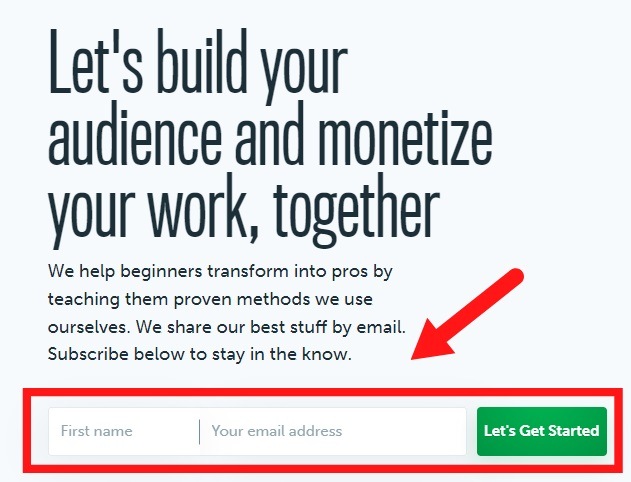
All by itself, the email capture form is all that's needed to trigger the requirement of a Privacy Policy being posted on the blog. However, the truth is that most bloggers don't just use an email capture form. They use that and many other methods as well.
A Contact Form
A super common feature on blogging websites is a form that allows visitors to get in touch with the blog's author. Similar to email capture forms, a contact form often captures many different personal data points.
Here's an example from Darren Rowse of ProBlogger:
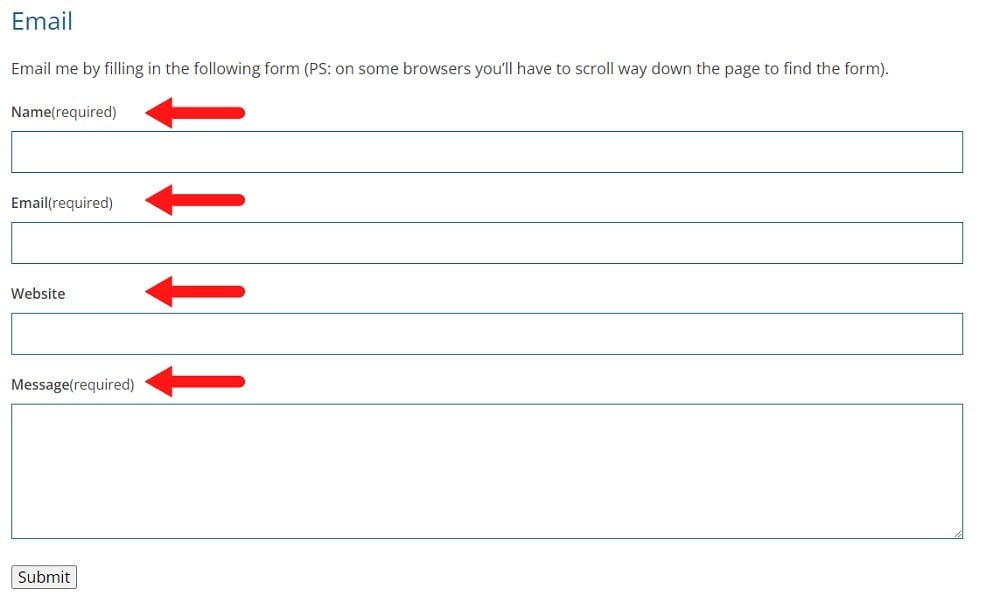
Notice that the contact form asks for the following personal information:
- Name
- Website
Live Chat Tools
Live chat can help you connect with readers in real time, and it can provide valuable insights into what makes your fans tick. If your blog engages in either ecommerce or affiliate marketing, these sorts of chat tools can also help turn casual blog readers into buyers.
However, the big deal for our purposes is that your readers have to give up some personal information if they wish to use the chat feature. Usually, that's an email address.
Chatbots
Similar in nature to Live Chats, a chatbot does much the same thing. It engages the blog's readers in a conversation. Chatbots usually answer questions or present FAQs, with the ultimate goal of getting the blog's visitors into a sales funnel.
Chatbots also collect personal information.
Social Sharing Tools
You know the value of ensuring your blog is up to date with fresh content. That's even more true of promoting that content. But creating new content regularly can be difficult, time-consuming, and downright overwhelming.
Luckily, social sharing tools help you get the word out. You might not think so, but each time one of your readers clicks to share a post, personal information is revealed through your blog's connection with the social platform in question.
Well-known blogger Yaro Starak places his social sharing icons in the sidebar of his blog as seen below:

Blog Post Comments Sections
Another common area where blog visitors typically give up personal information is within a blog's comments section. Usually, the visitor leaves a name and email address at a minimum.
Of course, this serves a dual purpose. You get the benefit of collecting useful personal information, and at the same time, you increase your blog's engagement and SEO.
Here's an example from ProBlogger:

Payment Checkouts
If you monetize your blog through ecommerce, then your checkout page is an area that collects a massive amount of personal data. The data collection methods on these types of pages can be both direct and indirect.
Notice the many fields the checkout form asks the visitor to fill out before processing their payment. Each of those data points is also shared with third parties.
Thus, having a page like this and collecting these types of information necessitates a Privacy Policy on the ecommerce blog.
Here's an example from Great Jones, an ecommerce site with an excellent blog:
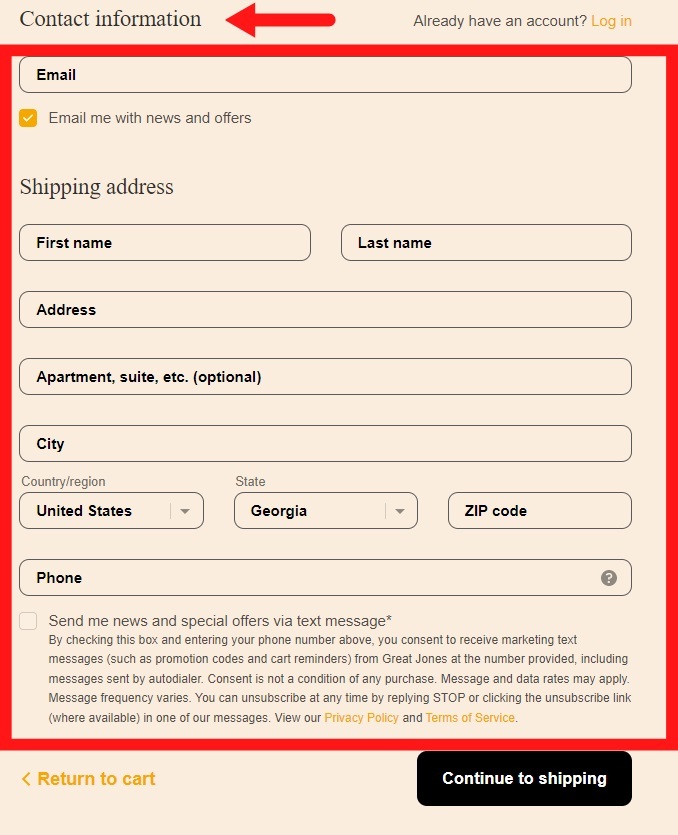
Notice just how much information the form above is asking from visitors.
Third Party Services
Some tasks are better handled by third-party tools when it comes to blogging. For example, here are a few reasons why blogs will use third-party tools:
- To create better content. Some tools can help you easily create graphs and charts to accompany your blog posts.
- To manage social media. Some services like Hootsuite allow you to easily manage all of your social media accounts from one place.
- To collect emails. Services like MailChimp and AWeber allow you to easily manage your email lists.
- For better analytics. Google Analytics is a common tool used for this.
You get the idea. These third-party services are standard, and they each collect your visitors' personal data.
Use of Cookies
Did you know that your computer automatically sends information back to the site owner when you visit a website? This is done through cookies, and you can use them to collect a surprising amount of personal information about you.
Cookies are small bits of data that are stored on your visitors' computers or mobile devices. They are used to collect the data necessary to track your visitors' movements around the web, collect information about their activities, and target ads.
In the case of blogging, cookies are often used as part of display and pay-per-click (PPC) activities.
What Information Your Blog's Privacy Policy Should Include

Before you get down to the serious business of writing a Privacy Policy for your blog, there are a few vital things to keep in mind.
A transparent and complete Privacy Policy agreement, which explains exactly what information you collect and how you use it, inspires trust in you and displays a level of integrity in your blog.
Secondly, remember that the tone of your Privacy Policy should be professional and informative. While you may have developed (or are working on developing) a cordial and friendly relationship with your readers, a Privacy Policy is a legal document.
You don't have to be overly formal, but you also don't want to be excessively familiar. With that said, here's what to include.
The Personal Information You Collect
The types of personal information you collect and how you collect it can all be put together in one area. If it is in separate sections because of the details you must provide, best practices are to place these clauses next to each other in the Privacy Policy.
One of the best ways to manage this section is to create a list using bullet points. There are no specific standards you have to follow here, but keep in mind that it can be hard to read when you bunch all the information up into a long paragraph.
Remember: You want the sections within your Privacy Policy to be easy to read and understood without difficulty.
Note how Yaro Starak lists the types of information collected on his blog:
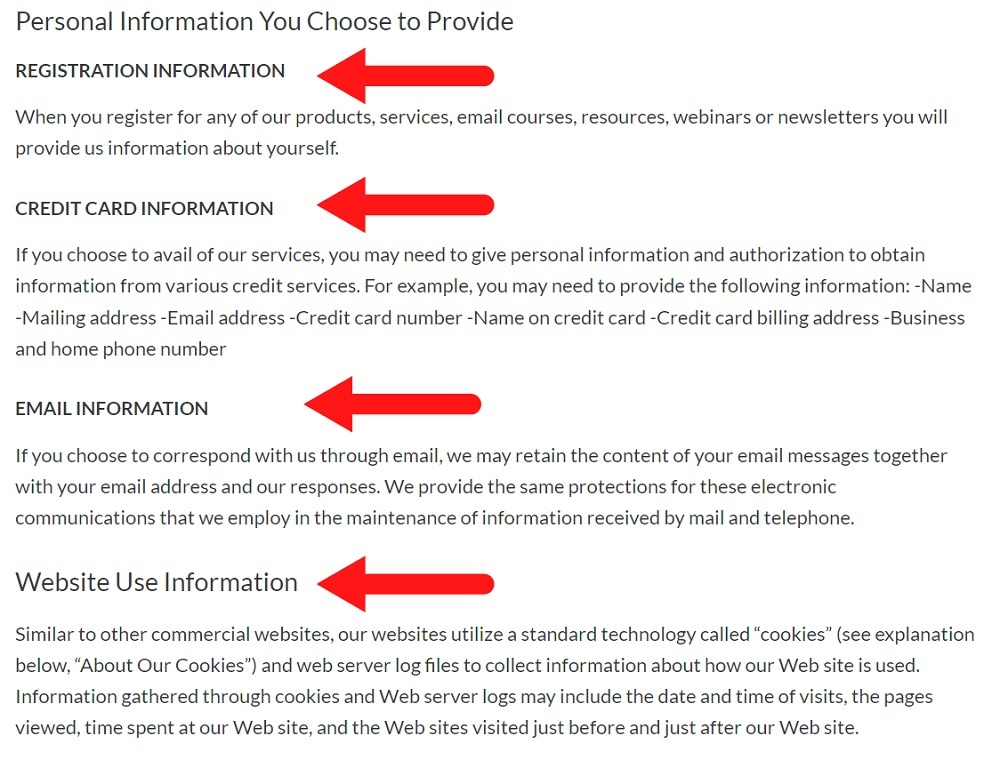
How/Why You Use the Information
Just as you must explain how you collect information, it's likewise essential to let your blog's visitors know how and why you use it.
For example, you may use the information for various reasons, including to provide any services, improve those services, personalize content, process payments, communicate with you, comply with laws and regulations, and more.
Here's how ProBlogger discloses this information:
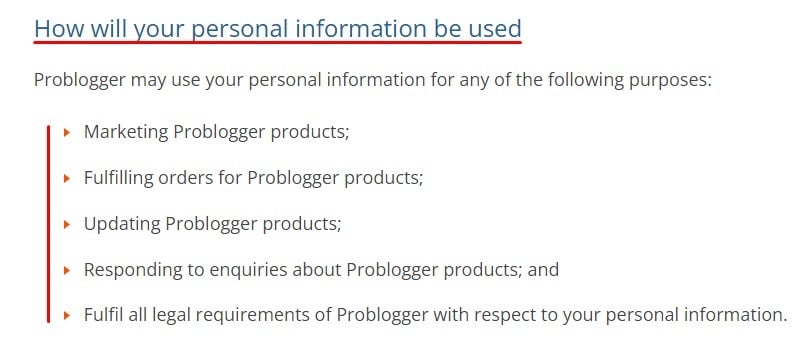
Third Party Disclosures
It's easy to see that there will be situations where your blog's readers may not want their information shared with a company other than yourself. It is important that they know about the possibility of such sharing in advance.
That way, if they don't consent or would like more control over what happens to their information when it's shared with others, they can make an informed decision before starting on your site (or any other).
With that in mind, if you do have a relationship with a third party that collects personal information, you must disclose that fact within your Privacy Policy.
Here's how Smart Passive Income does this:
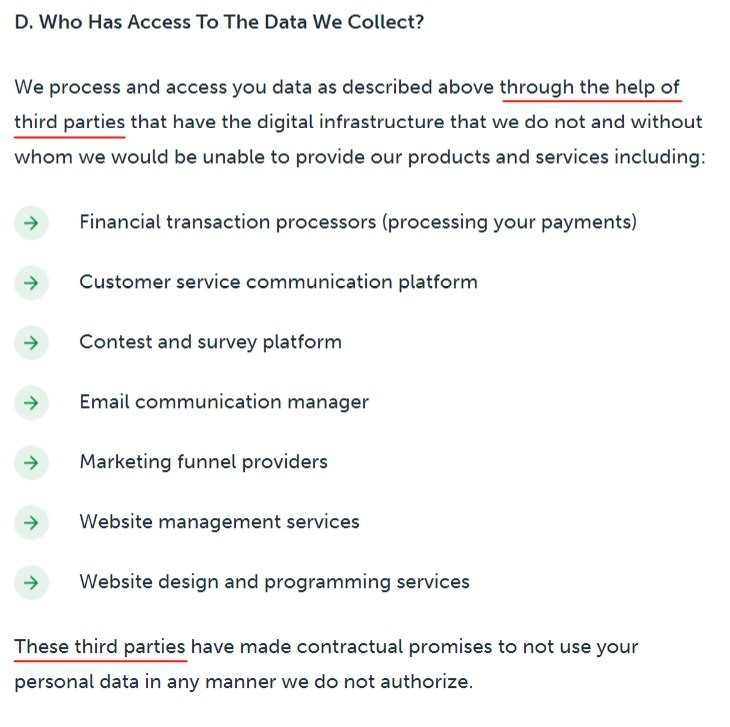
How You Protect Personal Information
What protections have you put in place to ensure that hackers or others don't gain access to your readers' personal information? In this section of your Privacy Policy, you need to note that you've put measures in place to secure the personal information you collect.
Here's how ProBlogger does this:
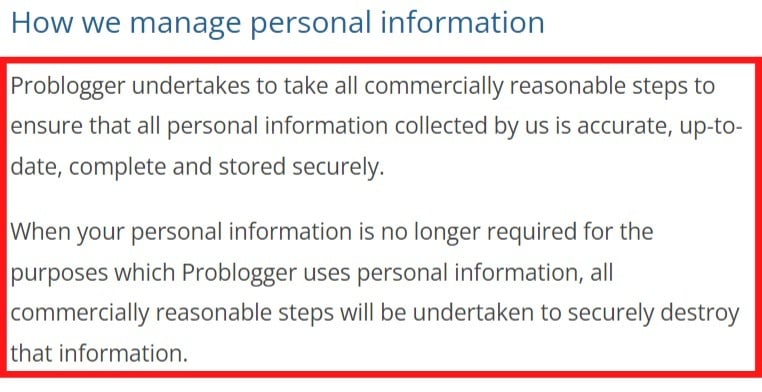
In addition, you should also list the contact information for your data protection officer (DPO) if you have one.
If you're located in Europe or collect the data of European residents, you must appoint a DPO
under the GDPR.
The Rights of Your Blog Visitors
Ensure your Privacy Policy is clear about the rights of users to delete data, make changes, and review data. Again, this is especially true if your blog collects the personal data of EU residents and the GDPR applies.
Here's how Smart Passive Income notes this and offers a way for readers to contact the blog to exercise the rights:
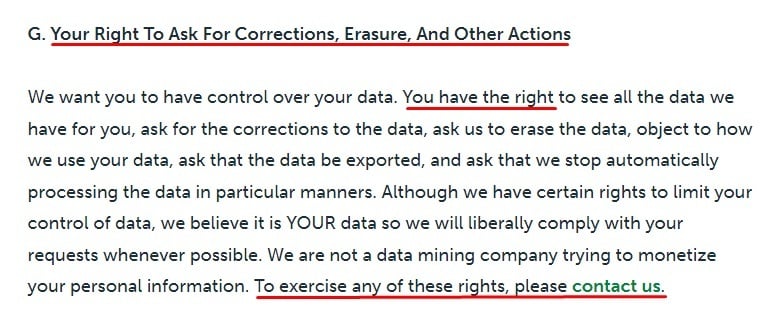
Notify Readers of Changes to Your Policy
As a responsible blogger, you have to keep your blog's users in the know about any changes to how you will use their information. Keep them in the loop with clear and concise announcements on revised Privacy Policies so that everyone understands what's going on. Not only is this required by law, but it also builds trust between you and your readers.
This section is usually quite brief, but it is important enough to have its own heading and section. Here's how Smart Passive Income does this:
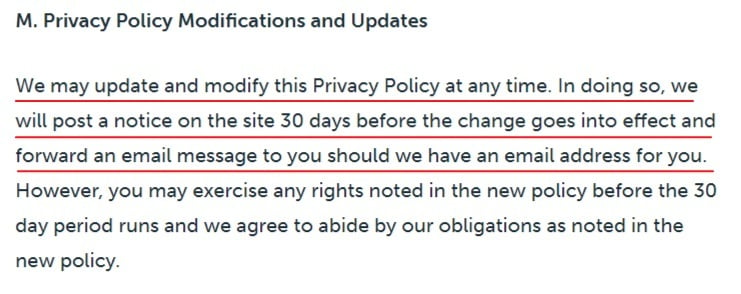
Contact Information
By now, you should understand how vital it is to be transparent with your customers about what information you're collecting and why.
That's why your blog's Privacy Policy should include your contact information. Including your contact information will help reassure your customers that you're serious about protecting their privacy and that they can get in contact if they have any questions or concerns.
It will also make it easier for them to contact you if they want to unsubscribe from your email list or update their subscription preferences.
Here's how ProBlogger does this in its Privacy Policy:

Where to Display a Blog's Privacy Policy
You should display your Privacy Policy URL at least in your blog's website footer. This will ensure it will show up to users from every page of your blog.
Here's an example of a Privacy Policy URL in a site footer:
![]()
If you have a cookie consent notice, you can (and should) include a link to your Privacy Policy within the notice, like so:
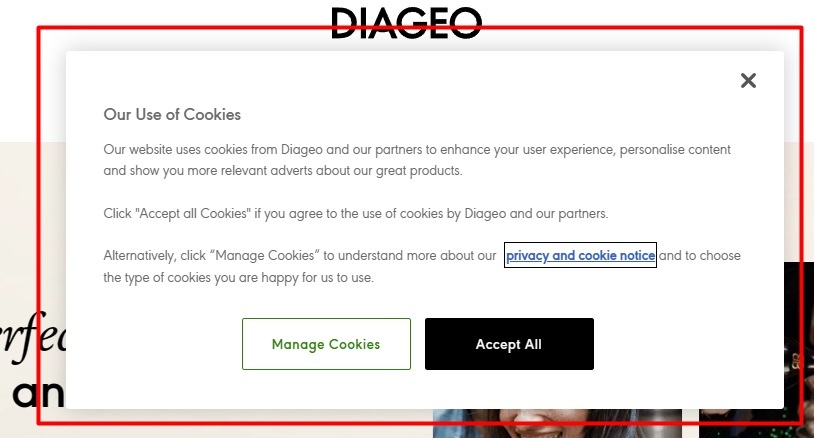
The general best practice is to include a link to your Privacy Policy wherever and whenever you ask users for their information. For example, if your blog has a newsetter, you can link your Privacy Policy to the form where you request their email address to subscribe them to your email list:
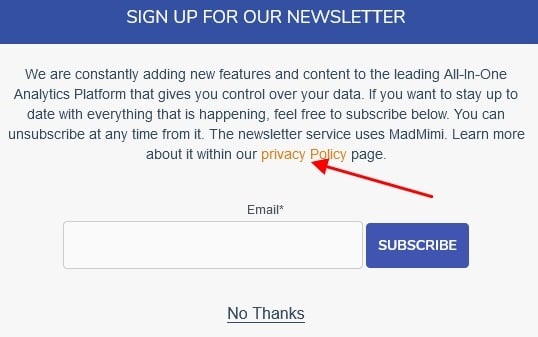
Summary of a Blog Privacy Policy
Your Privacy Policy is a significant component of user confidence and legal compliance. The basics covered in this article will help you write a Privacy Policy for your blog that is effective and compliant in most jurisdictions worldwide.
If you spend time considering your information practices and you gather the necessary details before you write your first draft, the task will be less daunting and your finished Privacy Policy will be more thorough and accurate.
The right template can provide you with the inspiration and structure you need. When writing your Privacy Policy, we suggest using the template we provide rather than taking bits and pieces that sound good from other bloggers' policies. This is because you want to ensure that the clauses you include are as relevant as possible.
An alternative we recommend is using our Privacy Policy Generator, which is a great tool. It will ask you applicable questions regarding your blog and the information you collect, and generate a Privacy Policy you can put to use immediately.
Download Sample Blog Privacy Policy Template
Generate a Privacy Policy in just a few minutes
Our Sample Blog Privacy Policy is available for download, for free. The template includes these sections:
- Definitions
- Collecting and Using Personal Information
- Usage Data
- Use of Personal Information
- Transfer of Personal Information
- Disclosure of Personal Information
- Security of Personal Information
- Detailed Information on the Processing of Your Personal Data
- Links to Other Websites
- Changes to Privacy Policy
- Contact Information
Sample Blog Privacy Policy Template (HTML Text Download)
You can download the Sample Blog Privacy Policy Template as HTML code below. Copy it from the box field below (right-click > Select All and then Copy-paste) and then paste it on your website pages.
Sample Blog Privacy Policy Template (PDF Download)
Download the Sample Blog Privacy Policy Template as a PDF file
Sample Blog Privacy Policy Template (Word DOCX Download)
Download the Sample Blog Privacy Policy Template as a Word DOCX file
Sample Blog Privacy Policy Template (Google Docs)
Download the Sample Blog Privacy Policy Template as a Google Docs document
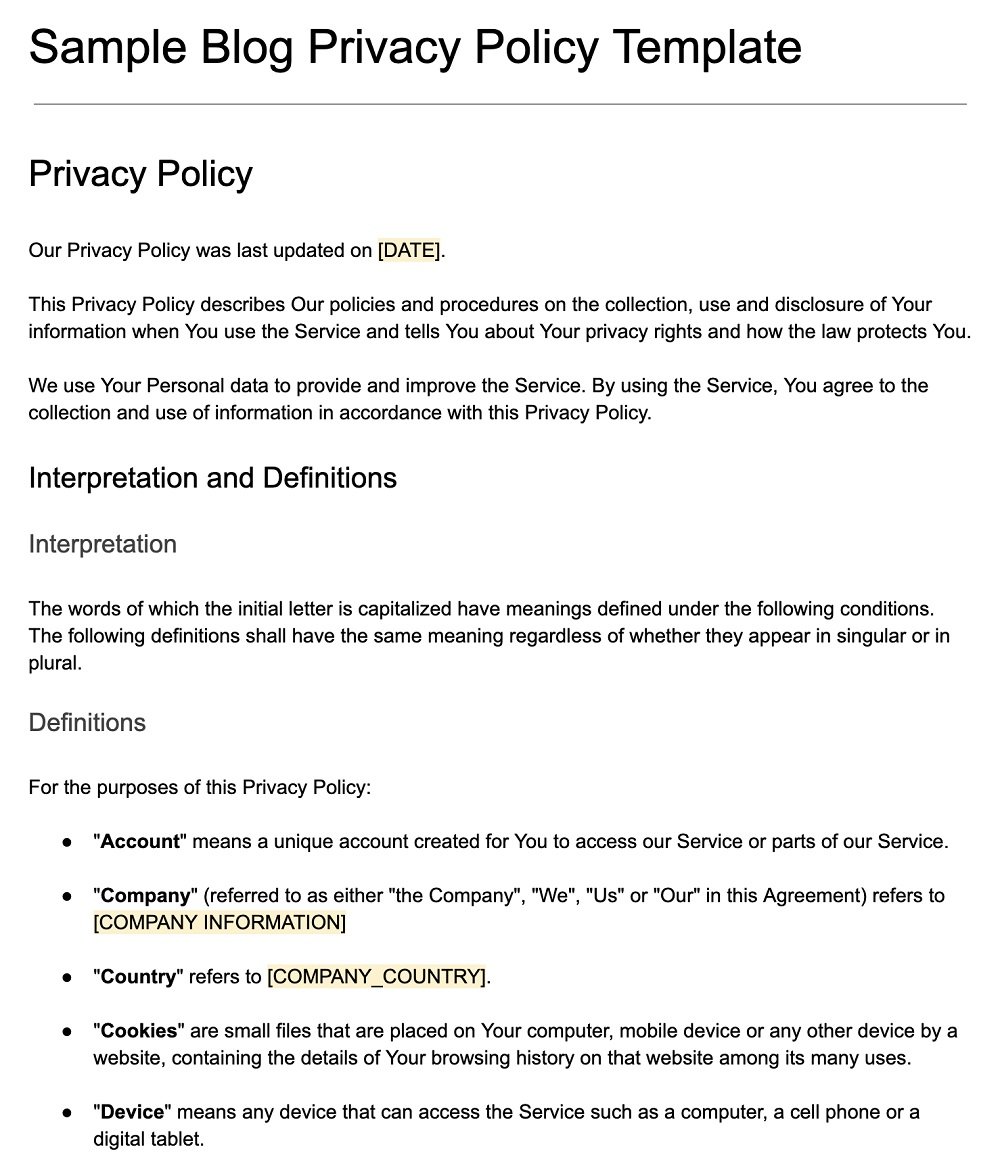
More Privacy Policy Templates
More specific Privacy Templates are available on our blog.
| Sample Privacy Policy Template | A Privacy Policy Template for all sorts of websites, apps and businesses. |
| Sample Mobile App Privacy Policy Template | A Privacy Policy Template for mobile apps on Apple App Store or Google Play Store. |
| Sample GDPR Privacy Policy Template | A Privacy Policy Template for businesses that need to comply with GDPR. |
| Sample CCPA Privacy Policy Template | A Privacy Policy Template for businesses that need to comply with CCPA. |
| Sample California Privacy Policy Template | A Privacy Policy Template for businesses that need to comply with California's privacy requirements (CalOPPA & CCPA). |
| Sample Virginia VCDPA Privacy Policy Template | A Privacy Policy Template for businesses that need to comply with Virginia's VCDPA. |
| Sample PIPEDA Privacy Policy Template | A Privacy Policy Template for businesses that need to comply with Canada's PIPEDA. |
| Sample Ecommerce Privacy Policy Template | A Privacy Policy Template for ecommerce businesses. |
| Small Business Privacy Policy Template | A Privacy Policy Template for small businesses. |
| Privacy Policy for Google Analytics (Sample) | A Privacy Policy Template for businesses that use Google Analytics. |
| Sample CalOPPA Privacy Policy Template | A Privacy Policy Template for businesses that need to comply with California's CalOPPA. |
| Sample SaaS Privacy Policy Template | A Privacy Policy Template for SaaS businesses. |
| Sample COPPA Privacy Policy Template | A Privacy Policy Template for businesses that need to comply with California's COPPA. |
| Sample CPRA Privacy Policy Template | A Privacy Policy Template for businesses that need to comply with California's CPRA. |
| Blog Privacy Policy Sample | A Privacy Policy Template for blogs. |
| Sample Email Marketing Privacy Policy Template | A Privacy Policy Template for businesses that use email marketing. |

Comprehensive compliance starts with a Privacy Policy.
Comply with the law with our agreements, policies, and consent banners. Everything is included.
